Feature Overview
At a glance these are RebeccaAIML's distinguishing features
- A windows installer
- An Eclipse plugin for using Eclipse as an AIML editor
- An embedded database engine for all AIML processing
- Support for a multitude of programming languages such as
C++, C#, Java, and Python
- Excellent, fully documented, and easy to use
APIs for various programming languages
- Support for safe and concurrent multi-process access to AIML
- Support for safe and concurrent multi-threading access to AIML
- Includes command line tools to access and manipulate the AIML
embedded database
- Support for multiple users, multiple bots the users
can have, and multiple end users accessing the users' bots
- Scalability. RebeccaAIML can support an infinite number of users,
bots, and, end users as long as you have hard drive space for
more.
- Near zero start times. Regardless of your number of users,
bots, end users, RebeccAIML will restart in ~ 1 second.
- A configurable amount of memory. Utilizing the embedded database
tools you can configure how much memory RebeccaAIML will use for
caching as well as fine tune her from a small machine to a large
rack server.
- Server and client model included. RebeccaAIML starts as a service
and runs as a server in the background waiting for queries
The Embedded Database
RebeccaAIML utilizes
Oracle's berkeley db for her embedded database
for all AIML processing.
AIML processing is whenever you add a new file to the "brain", remove
a file from the "brain", or query the brain for a response.
The first time RebeccaAIML is started she creates her database in
%ALLUSERSPROFILE%\.RebeccaAIML underneath Windows. Typically this is:
C:\Documents and Settings\All Users\.RebeccaAIML
on a standard windows installed system. If you de-install RebeccaAIML
she will delete that entire directory so you don't have left over "brains"
on your system. Also, at any given time, you can shut down RebeccaAIML's
server and any other processes that are accessing the embedded database and delete
the above .RebeccaAIML directory. The next time you restart any process
written using RebeccaAIML the above directory will be recreated again.
Just remeber, though, if you do delete the above directory you are effectevly erasing
all users, bots, and end users that might exist in the database. They will
all have to be re-added again.
RebeccaAIML uses the most common defaults of the embedded datbase. However,
with the Oracle berkeley db it is possible to do a range of extra options such as
hot backing it up, restoring it, utilizing redudancy, improving throughput, etc...
So many options that I cannot list them all here (I'd hurt my hand). You can cruise to
Oracle's berkeley db web site
if you ever need to use these more advanced features of the db.
Multi-User, Multi-Bot, Multi-EndUser Concepts
RebeccaAIML supports multi-user, multi-bot, and multi-enduser.
Using the same embedded database "brain" multiple users of the brain can co-exist. A user
is someone or something which wants one or more bots for their use. Multi-bot means that
a user can have one or more bots. Multi-EndUser means multiple end users can query users'
bots.
For each programming language and for any of the admin tools such as rs-admin, there exists
a mechanism for setting the user id, bot id, and end user id. Use this mechansim for setting
your user, bot, and end user id before adding, deleting, or querying AIML files. By default
if you do not set any of the id's RebeccaAIML will use the id of "default" for the user, bot,
and end user id.
When would you want to set or use a different user id? If you were writing a web application
which utilizes RebeccaAIML and you wanted to allow different users of your site to create,
access, and see their bots but not yours. Another scenario would be if you were writing seperate
applications and you wanted to keep the bots of one application completely seperate from the
other application. By using different users, different applications can use the same bot ids and
not have to worry about stomping on the each other's bots.
When would you want to set or use a different bot id? If you were writing a web application
which utilizes RebeccaAIML and you wanted to allow different users of your site to create multiple
bots. Another scenario would be if you were writing an application and you wanted to have more than
one bot. Each bot has its own set of AIML files you load and is unique if they load different AIML
files.
When would you want to set or use a different end user id? Any time you have a different end user
accessing a user's bot you would set the end user id to a new value. If you don't do this, then
whenever one end user sets a predicate such as their name, all the other end users' names would have
their name set to this same value.
Installing from the RebeccaAIML.exe installer
Go to the download site and download the latest windows installer. Double
click on the installer executable. When it first comes up you will see the welcome splash screen.
Click next to begin the installation.

The next screen is the license screen. RebeccaAIML is distributed under the
GPLv3 license. You must
accept that license. If you are looking for commercial development with RebeccaAIML please contact
me for a commercial license.
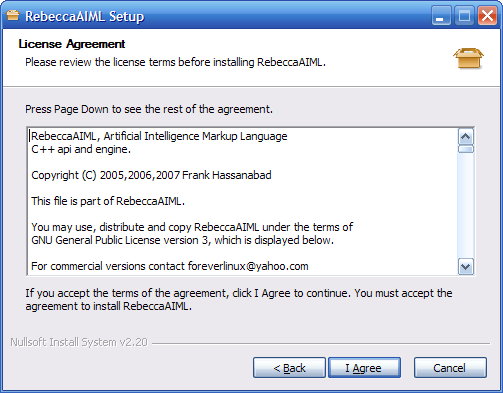
The next step allows you to define which parts of RebeccaAIML to install. She is broken up into
3 main parts. Networking, embedded, and documentation. I suggest to install everything. Why not?
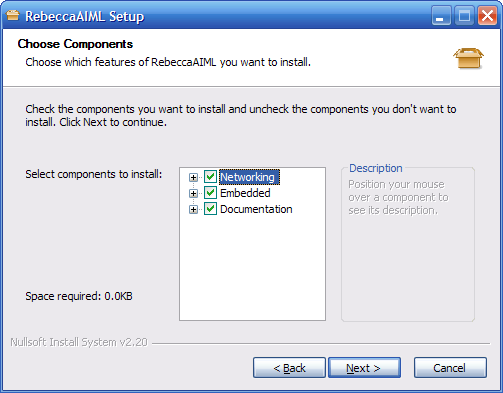
Networking consists of the standalone server which installs as a Windows service. The networking
section also contains the programming languages supported for network programming with RebeccaAIML.
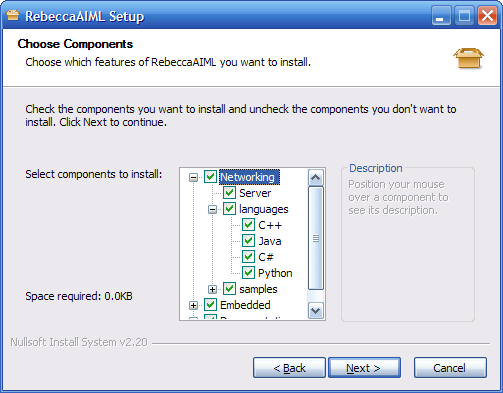
Networking also consists of several programming samples which showcase how to use the given programming
languages to easily program RebeccaAIML to do what you would want her to do. One sample I highly recommend
installing is the rs-admin sample. Although it is labeled a sample, it is a powerful command line
utility mentioned in this user guide which allows manipulation of RebeccaAIML from the command line.
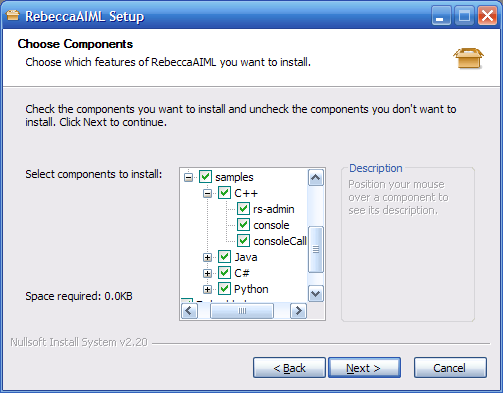
The embedded section lists the programming languages that are supported for direct manipulation of RebeccaAIML.
Although the list is shorter than the networking section, don't let that discourage your usage. Most of the time
you would want to use the networking language support and RebeccaAIML's server and not the embedded
language support.
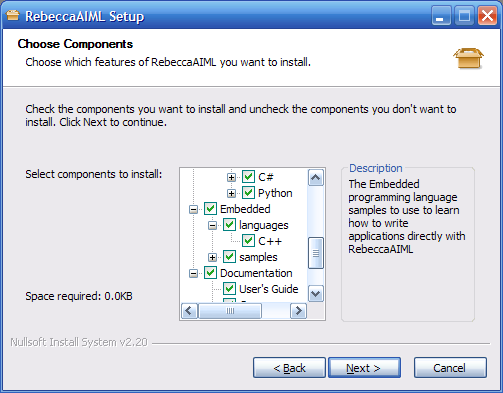
The documentation section lists the documentation to install. The programming language documentation is the api
documentation for each of those languages. The user guide is this document you are reading here.
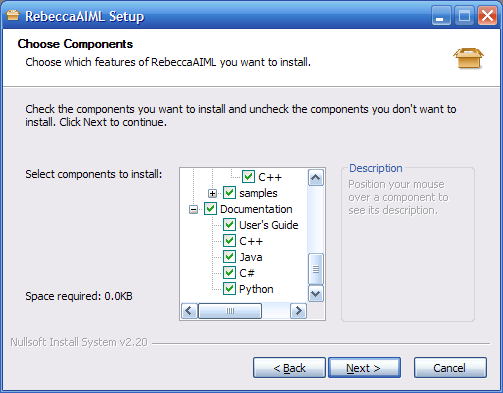
After deciding which parts you want installed and having clicked next you will see the
default location of where RebeccaAIML wants to install to. Change this if you want to or
keep it the default. Click next.
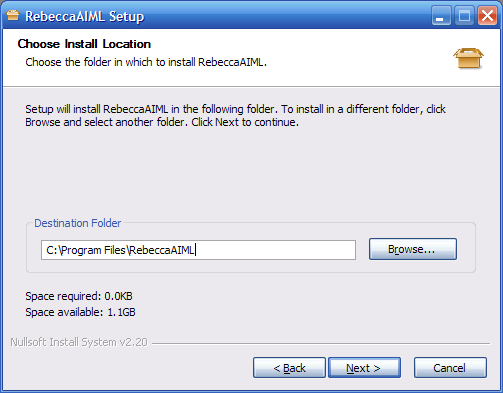
Change the Start Menu Folder if you really want to. Send me an email if you actually do because
you'd probably be the first ;-). Click next (final time I promise)
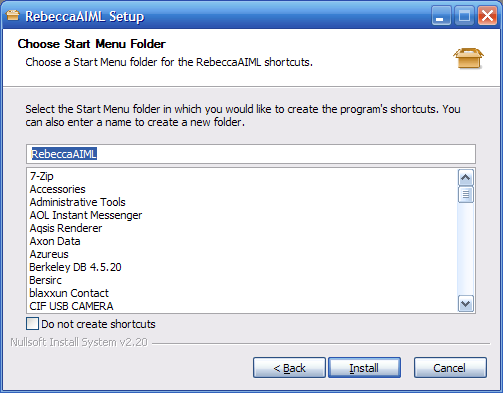
At the begining of the installation you will see RebeccaAIML install the C++ 2005 redistributable.
This is because RebeccaAIML's C++ is built with VS 2005 and needs to install the side by side 2005 .dll's.
This part takes a minute or two so be patient.
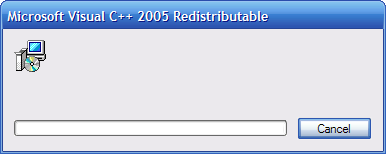
Almost there. The installation should show the progress like below getting towards the end
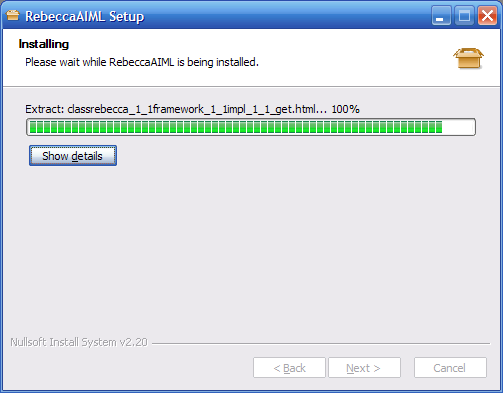
If everything went well you will see this final screen. Click finish and you're done.
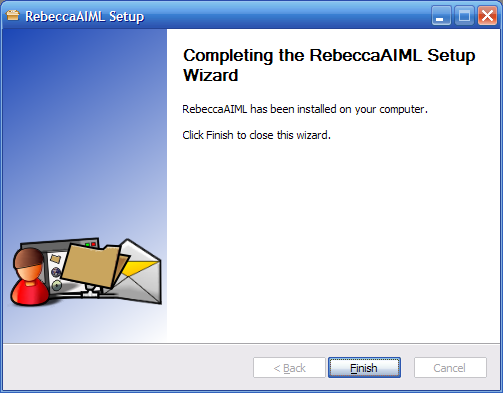
Upgrading to a new install of RebeccaAIML
If you do not care about the contents of your embedded database you can
simply uninstall the previous version and then install the new version.
You can always re-add any AIML files you had stored in the embedded
database from before using the rs-admin tool.
However, if you do care about the contents of the embedded database
and do not want to go through the trouble of re-adding everything you
will have to backup the database before uninstalling the older version
of RebeccaAIML and then restore the backup after installing the
new version.
To backup before uninstalling the older version of
RebeccaAIML go to your cpp\bin directory in your installation. In a
normal windows install this would be
C:\Program Files\RebeccaAIML\bin\cpp
Open a dos prompt and make the above cpp\bin your current working directory.
Use the shipped db_hotbackup executable to make your backup. Here I am
going to create a directory called backup at my root file system and then
create the backup. The "\" means to put everything on one line without the "\"
mkdir c:\backup
cd "C:\Program Files\RebeccaAIML\cpp\bin"
db_hotbackup -v -h \
"%ALLUSERSPROFILE%\Application Data\.RebeccaAIMLDB" \
-d "%ALLUSERSPROFILE%\Application Data\.RebeccaAIMLDB" \
-b c:\backup
See the homepage of db_hotbackup
for more information on usages of it.
After creating the backup, remove your current install of RebeccaAIML through
Start-> Programs-> RebeccaAIML-> Uninstall
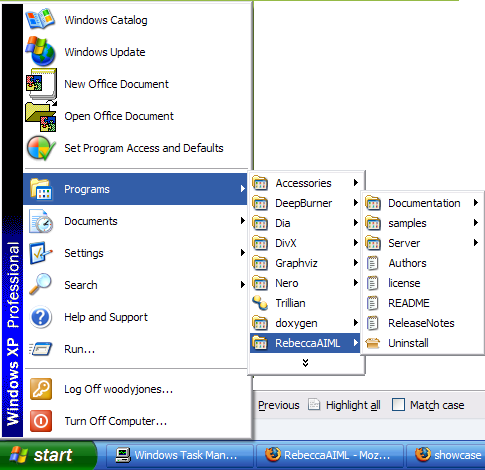
Install your new version like you normally would.
After your new installation is done installing, shut down the running
server through Start-> Programs-> RebeccaAIML-> Server->Stop
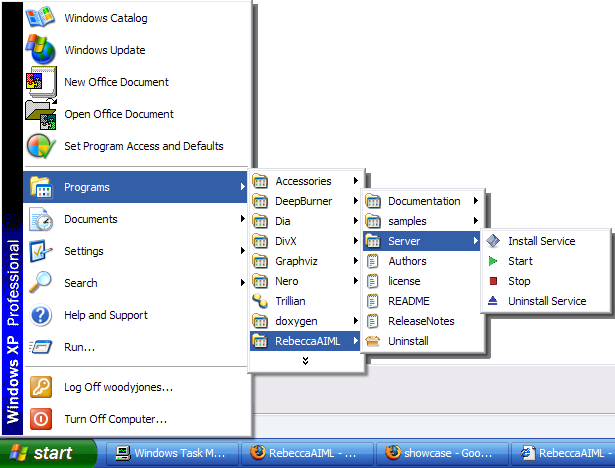
Delete any initial embedded database files the server created upon
startup at %ALLUSERSPROFILE%\Application Data\.RebeccaAIML. Underneath
windows this is typically
C:\Documents and Settings\All Users\.RebeccaAIML
After you delete those files, copy your backup files (c:\backup) to
the above directory.
You will need to recover the database files so they will work
with any upgrades to the berkeley db that might be in this new
release of RebeccaAIML. Go to your newly installed RebeccaAIML cpp\bin
directory and use the db_recover executable to recover the database
cd "C:\Program Files\RebeccaAIML\cpp\bin"
db_recover -h "%ALLUSERSPROFILE%\Application Data\.RebeccaAIMLDB
See the
db_recover homepage for more usages of it.
Finally, restart the server through Start->
Programs-> RebeccaAIML-> Server->Start
RebeccaAIML's Menus in Windows
After an installation underneath Windows you should now have various
menus in the main Start Menu of RebeccaAIML. Click the README file to
see which versions of the programming languages are supported. Click the
ReleaseNotes to see what has changed from the last version of RebeccaAIML.
If you no longer want RebeccaAIML on your system feel free to click the
uninstall option to completely remove her and any remnants of her from your
system.

Cruise furthur in the menu items and you should stumble upon the documentation
for each language if you have installed that feature. Click any of the documentation
web pages for any of the languages when you want to learn RebeccaAIML api's
for that particular langauage.
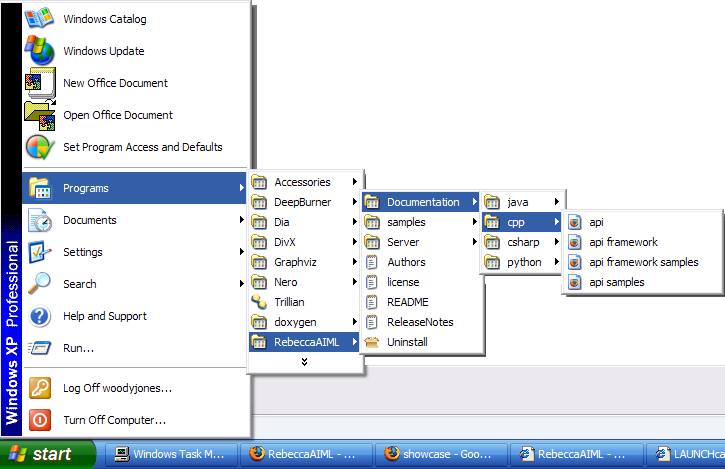
The quickest way to learn how to program with RebeccaAIML is to find the samples
section. You can launch each sample in turn if you would like to see each run. You
can also open or launch their respective build mechansims if you make changes to them
and rebuild them with your changes. See the README in the main menu for information on
which versions of the programming languages are supported.

The final section of the menu items you'll find is the server section. The server by
default should already be installed as a service under Windows and will restart each time
Windows is restarted. However, if you want to manually start, stop, remove, or re-add
the server, this is the place to do it.

RebeccaAIML's Included Server
RebeccaAIML utilizes the
Internet Communications Engine
to provide an included server which allows network programming. Network programming
allows various programming languages and command line tools to contact RebeccaAIML's
embedded database "brain" without having to directly contact the embedded database.
This allows client applications to be on seperate computers if desired.
Some programming languages only provide network support but don't let this discourage
you. Going through the server is the preferred mechanism when programming with
RebeccaAIML.
See RebeccaAIML's Menus in Windows on how to
start, stop, uninstall, and re-install the server. By default, RebeccaAIML's installer will
install the server as a Windows service and set it to start each time your computer is
started.
RebeccaAIML uses the most common defaults of the Internet Communications Engine. However,
with the Internet Communications Engine it is possible to do a range of extra options such as
setting thread pool size, improving throughput, etc...
So many options that I cannot list them all here (Man! would my hand hurt). You can cruise to
Internet Communications Engine
if you ever need to use these more advanced features of the server.
rs-admin Command Line Tool
Within the C++ samples I provide one called rs-admin. This command line tool can do just about
anything that any programming language api can do save for receiving callbacks. What this means
is that you can query different bots, add/remove AIML files, switch user,bot,enduser id's, and
query various AIML statistics all without having to write a single line of code.
To get to the proper directory where rs-admin lives use the following menu below. Notice
that you can optionally launch the VS 2005 solution and change rs-admin's code and recompile
it if you really wanted to. The code is fairly simple for the power it provides. Hench the
reason I provide it as a sample. For now let's just play with the prebuilt rs-admin. So click the rs-admin
console menu option.

You should now see the following dos console box pop up
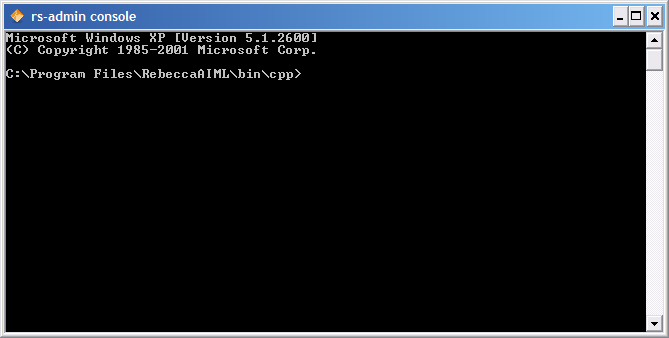
Type rs-admin and press enter. You should see about 5 screen full pages of text scroll past
and finally end up seeing this end message
Scroll up to see any individual usages of any
commands. You can use any of the commands in
conjuntion with either local connect
(-lc, --localConnection) or set ids
(-sids, --setIds) or with both
Here are some examples
Query server for a response
rs-admin --getResponse "hi"
Query the embedded database without
going through the server
rs-admin --localConnection --getResponse "hi"
Query the server for a response
using the user id of myUser, bot id of myBot
and the end user of myEndUser
rs-admin --setIds "myUser" "myBot" "myEndUser" --getResponse "hi"
Query the server for a response
using the user id of myUser, bot id of myBot
and the end user of myEndUser using the embedded
database without going through the server
rs-admin -lc -sids "myUser" "myBot" "myEndUser" -gr "hi"
The 5 screen full pages of text that scrolled past earlier were all
commands that rs-admin supports. You can scroll up to see all those
commands using your dos box or you can "redirect" them to a text file
for reading like so
rs-admin > command_text.txt
You can open that text file with your favorite text editor to see
the full list of commands that rs-admin supports
Let me show you some of the basic funtions of rs-admin and the power
it can deliver as a command line administration tool. First, let us
see if there are any AIML files loaded with the "default" user, bot,
and end user id:
rs-admin --getAIMLFileListSize
If you see a 0, then no files are loaded yet. We can remedy that pretty
quick using the rs-admin command --addDirectoryUnlessAlreadyAdded.
I will use the shortened version of the command which is -aduaa.
Every command line option has a long version prefixed with a "--"
and a short version prefixed with a "-".
rs-admin -aduaa "C:\Program Files\RebeccaAIML\aiml\annotated_alice"
The command prompt should come back pretty quick. If you try the
above command "--getAIMLFileListSize" again you'll still see a 0.
But why!? The reason is that the action of adding AIML files/directories
to the internal queue for processing and the action of actually parsing
them is seperate. So we will have to execute one more command, the
--createGraph, to process the files into the AIML bot brain now that we
have added them to the internal queue.
rs-admin --createGraph
Now you should see the command prompt take a few seconds to return and your computer's
CPU should be spiking to almost 100% while the files are loading. At this point RebeccaAIML is processing
the AIML files into the embedded database. After you get the command prompt back,
issue a "--getAIMLFileListSize" and you should see 50. That's how many AIML files
are now loaded under the default user, bot, and end user id. If want to see which files
are loaded into a particular user's bot you can issue the following command of
rs-admin --getAIMLFileList
If you issue that command now you should get this output
C:\Program Files\RebeccaAIML\bin\cpp>rs-admin --getAIMLFileList
C:\Program Files\RebeccaAIML\aiml\annotated_alice\AI.aiml
C:\Program Files\RebeccaAIML\aiml\annotated_alice\ALICE.aiml
C:\Program Files\RebeccaAIML\aiml\annotated_alice\Adverbs.aiml
C:\Program Files\RebeccaAIML\aiml\annotated_alice\Astrology.aiml
C:\Program Files\RebeccaAIML\aiml\annotated_alice\Atomic.aiml
C:\Program Files\RebeccaAIML\aiml\annotated_alice\Biography.aiml
C:\Program Files\RebeccaAIML\aiml\annotated_alice\Bot.aiml
C:\Program Files\RebeccaAIML\aiml\annotated_alice\Botmaster.aiml
C:\Program Files\RebeccaAIML\aiml\annotated_alice\Client.aiml
C:\Program Files\RebeccaAIML\aiml\annotated_alice\Computers.aiml
C:\Program Files\RebeccaAIML\aiml\annotated_alice\Date.aiml
C:\Program Files\RebeccaAIML\aiml\annotated_alice\Default.aiml
C:\Program Files\RebeccaAIML\aiml\annotated_alice\Drugs.aiml
C:\Program Files\RebeccaAIML\aiml\annotated_alice\Emotion.aiml
C:\Program Files\RebeccaAIML\aiml\annotated_alice\Food.aiml
C:\Program Files\RebeccaAIML\aiml\annotated_alice\Geography.aiml
C:\Program Files\RebeccaAIML\aiml\annotated_alice\Gossip.aiml
C:\Program Files\RebeccaAIML\aiml\annotated_alice\History.aiml
C:\Program Files\RebeccaAIML\aiml\annotated_alice\Humor.aiml
C:\Program Files\RebeccaAIML\aiml\annotated_alice\IU.aiml
C:\Program Files\RebeccaAIML\aiml\annotated_alice\Inquiry.aiml
C:\Program Files\RebeccaAIML\aiml\annotated_alice\Interjection.aiml
C:\Program Files\RebeccaAIML\aiml\annotated_alice\Knowledge.aiml
C:\Program Files\RebeccaAIML\aiml\annotated_alice\Literature.aiml
C:\Program Files\RebeccaAIML\aiml\annotated_alice\Money.aiml
C:\Program Files\RebeccaAIML\aiml\annotated_alice\Movies.aiml
C:\Program Files\RebeccaAIML\aiml\annotated_alice\Music.aiml
C:\Program Files\RebeccaAIML\aiml\annotated_alice\Parts.aiml
C:\Program Files\RebeccaAIML\aiml\annotated_alice\Personality.aiml
C:\Program Files\RebeccaAIML\aiml\annotated_alice\Philosophy.aiml
C:\Program Files\RebeccaAIML\aiml\annotated_alice\Pickup.aiml
C:\Program Files\RebeccaAIML\aiml\annotated_alice\Politics.aiml
C:\Program Files\RebeccaAIML\aiml\annotated_alice\Predicates.aiml
C:\Program Files\RebeccaAIML\aiml\annotated_alice\Psychology.aiml
C:\Program Files\RebeccaAIML\aiml\annotated_alice\Reduce.aiml
C:\Program Files\RebeccaAIML\aiml\annotated_alice\Reducer.aiml
C:\Program Files\RebeccaAIML\aiml\annotated_alice\Reductions.aiml
C:\Program Files\RebeccaAIML\aiml\annotated_alice\Religion.aiml
C:\Program Files\RebeccaAIML\aiml\annotated_alice\Salutations.aiml
C:\Program Files\RebeccaAIML\aiml\annotated_alice\Science.aiml
C:\Program Files\RebeccaAIML\aiml\annotated_alice\Sex.aiml
C:\Program Files\RebeccaAIML\aiml\annotated_alice\Spam.aiml
C:\Program Files\RebeccaAIML\aiml\annotated_alice\Sports.aiml
C:\Program Files\RebeccaAIML\aiml\annotated_alice\Stack.aiml
C:\Program Files\RebeccaAIML\aiml\annotated_alice\Stories.aiml
C:\Program Files\RebeccaAIML\aiml\annotated_alice\That.aiml
C:\Program Files\RebeccaAIML\aiml\annotated_alice\Utilities.aiml
C:\Program Files\RebeccaAIML\aiml\annotated_alice\Wallace.aiml
C:\Program Files\RebeccaAIML\aiml\annotated_alice\Xfind.aiml
C:\Program Files\RebeccaAIML\aiml\annotated_alice\update.aiml
Now let us query the AIML for a response. Issue the --getResponse command saying
"hi"
rs-admin --getResponse "hi"
And you should see something along the lines of this in your terminal
rs-admin --getResponse "hi"
Hello there.
That's the bot's response to you! It is talking to you now that it has AIML
files loaded. Let us see how many predicates and how many bot predicates
are loaded. Bot predicates are variables that associate given things such as
a bot's name, emotions, age, etc... with a particular bot. Regular predicates
are variables that associate given things such as a end user's name, emotions,
age, etc... with a particular end user. Let us retrieve all the bot predicates
for the default user's default bot.
rs-admin --getBotPredicates
We should see this long list of bot predicates that are already associated with
our default bot for our default user.
AGE
BASEBALLTEAM
BIRTHDAY
BIRTHPLACE
BOYFRIEND
BUILD
CELEBRITIES
CELEBRITY
CLASS
EMAIL
EMOTIONS
ETHICS
ETYPE
FAMILY
FAVORITEACTO
FAVORITEACTR
FAVORITEARTI
FAVORITEAUTH
FAVORITEBAND
FAVORITEBOOK
FAVORITECOLO
FAVORITEFOOD
FAVORITEMOVI
FAVORITESONG
FAVORITESPOR
FEELINGS
FOOTBALLTEAM
FORFUN
FRIEND
FRIENDS
GENDER
GENUS
GIRLFRIEND
HOCKEYTEAM
IP
KINDMUSIC
KINGDOM
LANGUAGE
LOCATION
LOOKLIKE
MASTER
NAME
NATIONALITY
ORDER
ORIENTATION
PARTY
PHYLUM
PRESIDENT
QUESTION
RELIGION
SIGN
SIZE
SPECIES
TALKABOUT
VERSION
VOCABULARY
WEAR
WEBSITE
Each of these bot predicates should have a value of at least an empty string.
Most will have a real value since whenever the RebeccaAIML server starts she
initializes the default user and default bot with particular values. Let us
get the value of one of the bot predicates in the list above. Issue the
command --getBotPredicate followed by one of the predicates in the list above.
I'll get the bot predicate "name" which defines the bot's name.
rs-admin --getBotPredicate name
I should see
Rebecca
outputted to me. Let me test this also by
directly asking my bot what its name is by the --getResponse. Notice I
use double quotes to make my question count as one argument to the rs-admin tool.
rs-admin --getResponse "What is your name?"
And the bot replies
My name is Rebecca.
Let me change the name and gender of my bot. I'll use the "--setBotPredicate" to
change both bot predicates
rs-admin --setBotPredicate "name" "John"
rs-admin --setBotPredicate "gender" "Male"
Now if you do a query asking the bot what its name or gender is you should see it
tell you that its name is john and its gender is that of a male. Let us try it.
rs-admin --getResponse "What is your name? What is your gender?"
You should see it respond back
My name is John. I am a Male. Are you a man or a woman?
I'll answer it and tell it I am a male
rs-admin --getResponse "I am a man"
It should now thank me for the information
Thanks for telling me your gender, . You are a "he".
Wait a second though. It seems to not know my name? Let me see exactly what it
knows about me, the end user, by querying for end user predicates.
rs-admin --getPredicates
We should see a very short list at this point. Topic is a built in predicate
for AIML processing and GENDER is what the bot has its self created.
TOPIC
GENDER
Since I told the bot my gender was male I bet if I query that predicate it will
return that I am a male.
rs-admin --getPredicate GENDER
he
Yep, it returns that I am a "he". Now what about my name? I could do a "--getResponse"
telling the bot directly my name. I could also set it directly through the command
"--setPredicate" too. One more option is to setup the most common predicates of the
annotated alice AIML files. To do this you call "--getResponse connect". Whenever the
annotated alice AIML bot sees the word connect the annotated alice AIML will create
user predicates with default values. I am going to use the connect key word to set
the predicates.
rs-admin --getResponse "connect"
I should see the bot say hi or some sort of greeting. Connect is programmed through AIML
and is specific to the annotated alice AIML set. Now if I do a "--getPredicates" I should
see a more extensive set of user predicates set with default values
rs-admin --getPredicates
AGE
BIRTHDAY
BOYFRIEND
BROTHER
CAT
DOES
DOG
EINDEX
EMAIL
ETYPE
FATHER
FAVCOLOR
FAVMOVIE
FIRSTNAME
FRIEND
FULLNAME
GENDER
GIRLFRIEND
HAS
HE
HEARD
HER
HIM
HUSBAND
IS
IT
JOB
LASTNAME
LIKE
LOCATION
LOOKLIKE
MEMORY
META
MIDDLENAME
MOTHER
NAME
NICKNAME
PASSWORD
PERSONALITY
PHONE
RELIGION
SHE
SIGN
SISTER
THEM
THEY
THOUGHT
TOP
TOPIC
WANT
WE
WIFE
Some other document I will probably talk more about the annotated_alice
AIML set that I ship with RebeccaAIML. For this user guide it falls out
of the scope. But be aware that if you call "connect" in your programming code
or through rs-admin with a particular end user, that end user's predicates
will be reset to default values.
Everything I've done up to this point has been direct manipulation of the
"default" user id, bot id, and end user id. What about if we want to use
the rs-admin tool to manipulate other users, bots, or end user ids? Simple,
you prefix any commands with the --setIds command. Say, for example, you
want to find out how many AIML files the bot "JohnsBot" which belongs to
the user "John" has and you want to find out through the end user also
called john.
rs-admin --setIds "John" "JohnsBot" "John" --getAIMLFileListSize
If you were to issue that command now you should get back a 0 since we
haven't loaded any aiml files for that user's bot. To add the files I can use
the command we used earlier of --addDirectoryUnlessAlreadyAdded and the
command --createGraph to add files for that user and bot. I will use
the shorter "-" versions for all of them this time. The "\" here means
to put the line below "-aduaa" all together on the same line.
rs-admin -sids "John" "JohnsBot" "John" -aduaa \
"C:\Program Files\RebeccaAIML\aiml\annotated_alice"
rs-admin -sids "John" "JohnsBot" "John" -cg
Notice that all commands to manipulate John and his bot have to have
the --setIds or -sids command prefixed. If you don't prefix it or forget to
you're manipulating the "default" user, bot, and end user. We can query
John's bot through any end user to get back the response from his bot. I'll
use the shortened version of --getResponse to say hi to his bot.
rs-admin -sids "John" "JohnsBot" "John" -gr "hi"
If I were to ask John's bot what its name is it should return back an empty
string since it is a seperate bot and its name has never been assigned to it.
rs-admin -sids "John" "JohnsBot" "John" -gr "what is your name"
My name is .
That's okay we can assign John's bot a name pretty easily using "--setBotPredicate"
if we wanted to. We could also parse a properties XML file to set the
bot predicate names too. Let us have John's bot parse all the same bot predicates
that the normal "default" bot parses. The "\" here means
to put the line below it all together on the same line.
rs-admin -sids "John" "JohnsBot" "John" \
--parsePropertiesFile \
"C:\Program Files\RebeccaAIML\conf\properties.xml"
Now if you ask it for its name or gender or any other bot predicate it should give
the same respsones as that of the "default" user and "default" bot.
So far we have been querying John's bot with the end user of "John". What if another
end user wants to query John's bot? If "John" tells the bot that his name is "John" and
"Kim" now queries the bot we don't want the bot thinking that Kim's name is
John. No problem. Each end user has their own set of predicates stored. For example
if John tells the bot that his name is John and Kim tells the bot that her name is
Kim
rs-admin -sids "John" "JohnsBot" "John" -gr "My name is John"
rs-admin -sids "John" "JohnsBot" "Kim" -gr "My name is Kim"
We should see the bot greet each in turn with a "hi how are you doing John" for John
and "hi how are you doing Kim" for Kim. But if we do a query of predictes
for the end user "John" and the end user "Kim" we should see that the predicates are indeed
set different for each one.
rs-admin -sids "John" "JohnsBot" "John" -gp "name"
John
rs-admin -sids "John" "JohnsBot" "Kim" -gp "name"
Kim
Okay, now I'm through with John's bot so let's remove the user John which will in turn remove
all of John's bots and end users. rs-admin has the capability to remove users,
bots, and end users. Here I'm going to remove John's entire user which will remove all
of his bots and end users.
rs-admin --removeUser "John"
This entire time we have been using rs-admin to connect to RebeccaAIML's
running server to do its queries. However, we can give it a switch to connect directly
to the embedded database and bypass the server altogether. This will be slower
than going through the server and will only work on the local machine running
the embedded database but I provide it none the less in case you cannot get the
server running or do not wish to run it. The switch to give it is the "--localConnection"
or "-lc" switch. Quick example to get a local response without going through
the server
rs-admin --localConnection --getResponse "hi"
The rs-admin is a powerful tool and I hope you find it as useful as I did for
debugging my code when I wrote it.
How to use C++ for programming with RebeccAIML
With C++ you can either program using the embedded or networking api for C++. I
recommend using the networking api since its far simpler and requires less boiler
plate. I will present two simple examples below and explain them. The first will
be using the networking api and the other will be using the embedded programming
api. These might be slightly different from the samples shipped with RebeccaAIML
but only because I want to make them as clear as possible here. The ones shipped
with RebeccaAIML have more comments and are more robust.
Let us start with a fully functional C++ bot application with
just a few lines of C++ code.
#include <rebecca/network_all.h>
using namespace rebecca;
#include <iostream>
#include <string>
using namespace std;
int main (int argc, char* args[])
{
try
{
NetworkAimlFacade aiml(argc, args);
NetworkGraphBuilder &builder =
aiml.getNetworkGraphBuilder();
cout << "[Type /exit to exit]"
<< endl << endl << endl;
string botName =
builder.getBotPredicate("name").c_str();
StringPimpl response =
builder.getResponse("connect");
//Send the initial opening line of the bot
cout << botName << " says: "
<< response.c_str() << endl;
while(true)
{
string input;
cout << "You say> ";
//Get input from the user from the keyboard
getline(cin, input);
if(input == "/exit")
{
break;
}
else //The user gave an input to the bot
{
StringPimpl response =
builder.getResponse(input.c_str());
cout << "====================="
<< endl << endl;
//Print out what Rebecca says.
cout << botName << " says: "
<< response.c_str() << endl;
}
} //end of while
} //end of try
catch(NetworkException &e)
{
cout << "[NetworkException Found Terminating]"
<< endl;
cout << "[" << e.what() << "]" << endl;
return 1;
}
catch(Exception &e)
{
cout << "[An uknown exception occured, "
"Terminating program]" << endl;
cout << "[" << e.what() << "]";
return 1;
}
//Everything smooth. Exit normally.
return 0;
Here is a break down of how the code above works. First include
all the RebeccaAIML networking header files and include her
namespace as well as some Standard Library header files for outputing
to your screen.
#include <rebecca/network_all.h>
using namespace rebecca;
#include <iostream>
#include <string>
using namespace std;
Next, create an instace of the NetworkAimlFacade feeding it your arguments from
your main. From that facade we get a handle to the GraphBuilder. The GraphBuilder
is where all your manipulations of AIML will occur. Once you have a handle to
the GraphBuilder you can pretty much do any manipulations like you would do with
the command line tool rs-admin.
NetworkAimlFacade aiml(argc, args);
NetworkGraphBuilder &builder =
aiml.getNetworkGraphBuilder();
Now, lets get the bot name and our first response from the bot. I tell the bot
"connect" and get its response back. The first thing I say to the bot is
"connect" because I'm using the annotated alice AIML set. Whenever you say
"connect" to the annotated alice AIML data set it will initialize
all of the end user predicates.
string botName =
builder.getBotPredicate("name").c_str();
StringPimpl response =
builder.getResponse("connect");
Finally, let us start a while loop where we read a line from the user of our
program. If the input is "/exit" we will break from our loop and return. If
it is not, we will feed the input into the bot and get back our response.
while(true)
{
string input;
cout << "You say> ";
//Get input from the user from the keyboard
getline(cin, input);
if(input == "/exit")
{
break;
}
else //The user gave an input to the bot
{
StringPimpl response =
builder.getResponse(input.c_str());
cout << "====================="
<< endl << endl;
//Print out what Rebecca says.
cout << botName << " says: "
<< response.c_str() << endl;
}
} //end of while
One thing you should notice is that I never fed any AIML files in the above
example to our bot. I just assumed that the AIML files were already added
from some other mechanism. If you want to add a directory you would use
the GraphBuilder and call "addDirectoryUnlessAlreadyAdded" or
"addFileUnlessAlreadyAdded" and then "createGraph".
For example, before your while loop, you could add
builder.addDirectoryUnlessAlreadyAdded
(
"C:\\Program Files\\RebeccaAIML\\aiml\\annotated_alice"
);
builder.createGraph();
Now I will show below a short example of the embedded C++ version. This version
is going to be more involved since you have to do more setting up compared to the
networking example. The networking sample is easier to write since the server
on startup handles a lot of the boiler plate code.
#include <rebecca/all.h>
using namespace rebecca;
#include <iostream>
#include <string>
using namespace std;
int main (int argc, char* args[])
{
try
{
//Get the GraphBuilder
AimlFacade aiml;
GraphBuilder &builder = aiml.getGraphBuilder();
//set schema locations
builder.setAIMLSchema
(
"C:\\Program\ Files\\RebeccaAIML\\resources\\schema\\AIML.xsd"
);
builder.setCommonTypesSchema
(
"C:\\Program\ Files\\RebeccaAIML\\resources\\schema\\common-types.xsd"
);
builder.setBotConfigurationSchema
(
"C:\\Program\ Files\\RebeccaAIML\\resources\\schema\\bot-configuration.xsd"
);
//set to true that we want to do XML validation
builder.setAIMLValidation();
builder.setBotConfigurationValidation();
//parse the substitutions file
builder.parseSubstitutionFile
(
"C:\\Program\ Files\\RebeccaAIML\\conf\\substitutions.xml"
);
//parse sentence splitters
builder.parseSentenceSplitterFile
(
"C:\\Program\ Files\\RebeccaAIML\\conf\\sentence-splitters.xml"
);
//parse bot properties
builder.parsePropertiesFile
(
"C:\\Program\ Files\\RebeccaAIML\\conf\\properties.xml"
);
//add the AIML directory unless its already added
builder.addDirectoryUnlessAlreadyAdded
(
"C:\\Program\ Files\\RebeccaAIML\\aiml\\annotated_alice"
);
builder.createGraph();
cout << "[Type /exit to exit]"
<< endl << endl << endl;
string botName =
builder.getBotPredicate("name").c_str();
StringPimpl response =
builder.getResponse("connect");
//Send the initial opening line of the bot
cout << botName
<< " says: "
<< response.c_str()
<< endl;
while(true)
{
string input;
cout << "You say> ";
//Get input from the user from the keyboard
getline(cin, input);
if(input == "/exit")
{
break;
}
else //The user gave an input to the bot
{
cout << endl
StringPimpl response =
builder.getResponse(input.c_str());
//output lines
cout << "====================="
<< endl << endl;
//Print out what Rebecca says.
cout << botName << " says: "
<< response.c_str()
<< endl;
}
} //end of while
} //end of try
catch(Exception &e)
{
cout << "[An uknown exception occured,"
" Terminating program]"
<< endl;
cout << "[" << e.what() << "]";
return 1;
}
return 0;
Here is a break down of how the code above works. First include
all the RebeccaAIML header files and include her
namespace as well as some Standard Library header files for outputing
to your screen.
//Rebecca includes
#include <rebecca/all.h>
using namespace rebecca;
//Std includes
#include <iostream>
#include <string>
using namespace std;
Next, create an instace of the AimlFacade. From that facade we get a handle
to the GraphBuilder. The GraphBuilder is where all your manipulations
of AIML will occur. Once you have a handle to the GraphBuilder you can
pretty much do any manipulations like you would do with the command
line tool rs-admin.
AimlFacade aiml;
GraphBuilder &builder = aiml.getGraphBuilder();
Now we'll inform RebeccaAIML of the locations of where our various
xsd's are. Xsd's are files which RebeccaAIML uses to figure out if
the XML she parses is valid or not. There's a few XML files
we'll have to load after this step.
//set schema locations
builder.setAIMLSchema
(
"C:\\Program\ Files\\RebeccaAIML\\resources\\schema\\AIML.xsd"
);
builder.setCommonTypesSchema
(
"C:\\Program\ Files\\RebeccaAIML\\resources\\schema\\common-types.xsd"
);
builder.setBotConfigurationSchema
(
"C:\\Program\ Files\\RebeccaAIML\\resources\\schema\\bot-configuration.xsd"
);
Now since we have gone through the trouble of loading xsd's we might
as well inform RebeccaAIML that, yes, we want to do XML validation.
XML validation is the process of validating whether or not XML files
we are processing are correct. Without XML validation if we were
to get a malformed XML file we would crash. With XML validation
we have a chance of not crashing and a chance of reporting what the
error within the file is.
builder.setAIMLValidation();
builder.setBotConfigurationValidation();
Almost done! We just have to load in our substitutions,
sentence splitters, and our bot properties. We load them through
XML files we have in our installation. Substitutions are words we
substitute for other words from the end user querying our
bots. For example, we might substitute commonly
mispelled words for their correct spelling. Sentence splitters
are what we use to determine what the end of a sentence is. For
example, a period "." would be a sentence splitter. Bot
properties are bot predicates that we want set on our bot.
//parse the substitutions file
builder.parseSubstitutionFile
(
"C:\\Program\ Files\\RebeccaAIML\\conf\\substitutions.xml"
);
//parse sentence splitters
builder.parseSentenceSplitterFile
(
"C:\\Program\ Files\\RebeccaAIML\\conf\\sentence-splitters.xml"
);
//parse bot properties
builder.parsePropertiesFile
(
"C:\\Program\ Files\\RebeccaAIML\\conf\\properties.xml"
);
Our final step is to add our AIML directory into
the embedded database "brain" (unless they've already
been added of course).
//add the AIML directory unless its already added
builder.addDirectoryUnlessAlreadyAdded
(
"C:\\Program\ Files\\RebeccaAIML\\aiml\\annotated_alice"
);
builder.createGraph();
Finally, let us start a while loop where we read a line from the user of our
program. If the input is "/exit" we will break from our loop and return. If
it is not, we will feed the input into the bot and get back our response.
while(true)
{
string input;
cout << "You say> ";
//Get input from the user from the keyboard
getline(cin, input);
if(input == "/exit")
{
break;
}
else //The user gave an input to the bot
{
StringPimpl response =
builder.getResponse(input.c_str());
cout << "====================="
<< endl << endl;
//Print out what Rebecca says.
cout << botName << " says: "
<< response.c_str() << endl;
}
} //end of while
How to use Java for programming with RebeccAIML
With Java you can program RebeccaAIML applications using the networking api.
I will present a simple example below and explain it.
This might be slightly different from the sample shipped with RebeccaAIML
but only because I want to make it as clear as possible here.
The one shipped with RebeccaAIML has more comments and is more robust.
Let us start with a fully functional Java bot application with
just a few lines of Java code.
import rebecca.NetworkAimlFacade;
import rebecca.GraphBuilder;
import rebecca.NetworkException;
import java.io.BufferedReader;
import java.io.InputStreamReader;
public class Console {
public static void main(String args[]) {
NetworkAimlFacade aiml = null;
int status = 0;
try {
aiml = new NetworkAimlFacade(args);
GraphBuilder builder =
aiml.getNetworkGraphBuilder();
String botName =
builder.getBotPredicate("name");
String initialResponse =
builder.getResponse("connect");
System.out.println(botName + " says: " +
initialResponse);
while(true) {
System.out.print("You say> ");
BufferedReader br =
new BufferedReader(new
InputStreamReader(System.in));
String input = br.readLine();
if(input.equals("/exit")) {
break;
} else {
String response =
builder.getResponse(input);
System.out.println("=====================");
//Print out what Rebecca says.
System.out.println(botName + " says: " +
response);
}
}
aiml.destroy();
} catch(NetworkException e) {
e.printStackTrace();
status = 1;
} catch (Exception e) {
e.printStackTrace();
status = 1;
}
System.exit(status);
}
}
Here is a break down of how the code above works. First
import the RebeccaAIML packages as well as some
java.io packages for outputing to your screen.
import rebecca.NetworkAimlFacade;
import rebecca.GraphBuilder;
import rebecca.NetworkException;
import java.io.BufferedReader;
import java.io.InputStreamReader;
Next, create an instace of the NetworkAimlFacade feeding it your arguments from
your main. From that facade we get a handle to the GraphBuilder. The GraphBuilder
is where all your manipulations of AIML will occur. Once you have a handle to
the GraphBuilder you can pretty much do any manipulations like you would do with
the command line tool rs-admin.
aiml = new NetworkAimlFacade(args);
GraphBuilder builder =
aiml.getNetworkGraphBuilder();
Now, lets get the bot name and our first response from the bot. I tell the bot
"connect" and get its response back. The first thing I say to the bot is
"connect" because I'm using the annotated alice AIML set. Whenever you say
"connect" to the annotated alice AIML data set it will initialize
all of the end user predicates.
String botName =
builder.getBotPredicate("name");
String initialResponse =
builder.getResponse("connect");
System.out.println(botName + " says: " +
initialResponse);
Finally, let us start a while loop where we read a line from the user of our
program. If the input is "/exit" we will break from our loop and return. If
it is not, we will feed the input into the bot and get back our response.
while(true) {
System.out.print("You say> ");
BufferedReader br =
new BufferedReader(new
InputStreamReader(System.in));
String input = br.readLine();
if(input.equals("/exit")) {
break;
} else {
String response =
builder.getResponse(input);
System.out.println("=====================");
//Print out what Rebecca says.
System.out.println(botName + " says: " +
response);
}
}
One thing you should notice is that I never fed any AIML files in the above
example to our bot. I just assumed that the AIML files were already added
from some other mechanism. If you want to add a directory you would use
the GraphBuilder and call "addDirectoryUnlessAlreadyAdded" or
"addFileUnlessAlreadyAdded" and then "createGraph".
For example, before your while loop, you could add
builder.addDirectoryUnlessAlreadyAdded
(
"C:\\Program\ Files\\RebeccaAIML\\aiml\\annotated_alice"
);
builder.createGraph();
How to use C# for programming with RebeccAIML
With C# you can program RebeccaAIML applications using the networking api.
I will present a simple example below and explain it. This might be
slightly different from the sample shipped with RebeccaAIML but only
because I want to make it as clear as possible here. The one shipped with
RebeccaAIML has more comments and is more robust.
Let us start with a fully functional C# bot application with
just a few lines of C# code.
using System;
using rebecca;
using rebecca.impl;
namespace console
{
class Console
{
static void Main(string[] args)
{
NetworkAimlFacade aiml = null;
int status = 0;
try
{
aiml = new NetworkAimlFacade(args);
GraphBuilder builder =
aiml.GetNetworkGraphBuilder();
string botName =
builder.GetBotPredicate("name");
string initialResponse =
builder.GetResponse("connect");
System.Console.WriteLine(botName + " says: " +
initialResponse);
while (true)
{
System.Console.Write("You say> ");
string input = System.Console.ReadLine();
if (input.Equals("/exit"))
{
break;
}
else
{
string response = builder.GetResponse(input);
//Print out what Rebecca says.
System.Console.WriteLine(botName +
" says: " + response);
}
}
}
catch (NetworkException e)
{
System.Console.WriteLine(e.ToString());
System.Console.Write(Environment.StackTrace);
}
catch (Exception e)
{
System.Console.WriteLine(e.ToString());
System.Console.Write(Environment.StackTrace);
}
finally
{
if (aiml != null)
{
aiml.Destroy();
}
}
System.Environment.Exit(status);
} //end of Main
} //end of Console
} //end of console
Here is a break down of how the code above works. First
import the RebeccaAIML packages as well as some
System packages for outputing to your screen.
using System;
using rebecca;
using rebecca.impl;
Next, create an instace of the NetworkAimlFacade feeding it your arguments from
your main. From that facade we get a handle to the GraphBuilder. The GraphBuilder
is where all your manipulations of AIML will occur. Once you have a handle to
the GraphBuilder you can pretty much do any manipulations like you would do with
the command line tool rs-admin.
aiml = new NetworkAimlFacade(args);
GraphBuilder builder =
aiml.GetNetworkGraphBuilder();
Now, lets get the bot name and our first response from the bot. I tell the bot
"connect" and get its response back. The first thing I say to the bot is
"connect" because I'm using the annotated alice AIML set. Whenever you say
"connect" to the annotated alice AIML data set it will initialize
all of the end user predicates.
string botName =
builder.GetBotPredicate("name");
string initialResponse =
builder.GetResponse("connect");
System.Console.WriteLine(botName + " says: " +
initialResponse);
Finally, let us start a while loop where we read a line from the user of our
program. If the input is "/exit" we will break from our loop and return. If
it is not, we will feed the input into the bot and get back our response.
while (true)
{
System.Console.Write("You say> ");
string input = System.Console.ReadLine();
if (input.Equals("/exit"))
{
break;
}
else
{
string response = builder.GetResponse(input);
//Print out what Rebecca says.
System.Console.WriteLine(botName +
" says: " + response);
}
}
One thing you should notice is that I never fed any AIML files in the above
example to our bot. I just assumed that the AIML files were already added
from some other mechanism. If you want to add a directory you would use
the GraphBuilder and call "addDirectoryUnlessAlreadyAdded" or
"addFileUnlessAlreadyAdded" and then "createGraph".
For example, before your while loop, you could add
builder.AddDirectoryUnlessAlreadyAdded
(
"C:\\Program\ Files\\RebeccaAIML\\aiml\\annotated_alice"
);
builder.CreateGraph();
How to use Python for programming with RebeccAIML
With Python you can program RebeccaAIML applications using the networking api.
I will present a simple example below and explain it.
This might be slightly different from the sample shipped with RebeccaAIML
but only because I want to make it as clear as possible here. The one
shipped with RebeccaAIML has more comments and is more robust.
Let us start with a fully functional Python bot application with
just a few lines of Python code.
from NetworkException import *
from NetworkAimlFacade import *
import sys
import traceback
status = 0
aiml = None
try:
aiml = NetworkAimlFacade(sys.argv)
builder = aiml.getNetworkGraphBuilder()
print '[Type /exit to exit]\n\n'
botName = builder.getBotPredicate('name')
response = builder.getResponse('connect')
print botName + ' says: ' + response
while 1:
input = raw_input('You say> ')
if input == '/exit':
break
else:
response = builder.getResponse(input)
print "=====================\n"
print botName + " says: " + response
except NetworkException, e:
print '[NetworkException Found Terminating]'
print '[' + str(e.what()) + ']'
traceback.print_exc()
status = 1
except Exception, e:
print '[An uknown exception occured,' +
Terminating program]'
print '[' + str(e.what()) + ']'
traceback.print_exc()
status = 1
if aiml:
aiml.destroy()
sys.exit(status)
Here is a break down of how the code above works. First
import the RebeccaAIML packages as well as some
sys packages for outputing to your screen.
from NetworkException import *
from NetworkAimlFacade import *
import sys
import traceback
Next, create an instace of the NetworkAimlFacade feeding it your arguments from
your main. From that facade we get a handle to the GraphBuilder. The GraphBuilder
is where all your manipulations of AIML will occur. Once you have a handle to
the GraphBuilder you can pretty much do any manipulations like you would do with
the command line tool rs-admin.
aiml = NetworkAimlFacade(sys.argv)
builder = aiml.getNetworkGraphBuilder()
Now, lets get the bot name and our first response from the bot. I tell the bot
"connect" and get its response back. The first thing I say to the bot is
"connect" because I'm using the annotated alice AIML set. Whenever you say
"connect" to the annotated alice AIML data set it will initialize
all of the end user predicates.
botName = builder.getBotPredicate('name')
response = builder.getResponse('connect')
print botName + ' says: ' + response
Finally, let us start a while loop where we read a line from the user of our
program. If the input is "/exit" we will break from our loop and return. If
it is not, we will feed the input into the bot and get back our response.
while 1:
input = raw_input('You say> ')
if input == '/exit':
break
else:
response = builder.getResponse(input)
print "=====================\n"
print botName + " says: " + response
One thing you should notice is that I never fed any AIML files in the above
example to our bot. I just assumed that the AIML files were already added
from some other mechanism. If you want to add a directory you would use
the GraphBuilder and call "addDirectoryUnlessAlreadyAdded" or
"addFileUnlessAlreadyAdded" and then "createGraph".
For example, before your while loop, you could add
builder.addDirectoryUnlessAlreadyAdded
(
'C:\\Program\ Files\\RebeccaAIML\\aiml\\annotated_alice'
);
builder.createGraph();
How to use any programming language or
seperate process with RebeccAIML
The anwser to this is really short and simple. You can always use the
rs-admin tool for any programming language or
running process which can call to the operating system shell. You can do
everything a supported programming language can do except for recieving
callbacks. So, why not for a programming or web language not officially supported
make a system call to rs-admin? Give it a try. I'm sure
you'll find rs-admin operates better than most AIML supported languages from
other platforms not as robust as RebeccaAIML.
Installing the Eclipse Plugin for AIML editing with RebeccaAIML
Before you do anything, ensure you have downloaded and installed RebeccaAIML. The plugin will not
operate or do anything without first downloading and installing RebeccaAIML.
To install the eclipse plugin, download the RebeccaAIML
eclipse plugin from the downloads section. Next, download eclipse from Eclipse's
download site. Download the
eclipse IDE for Java Developers. I know, I know, you're a AIML developer not a Java Devloper! However,
the java developer version has all the XML tools you will want and need.
Unzip the downloaded eclipse IDE for Java developers to a suitable location. I prefer to just use my
root directory of "C:\" under Windows.
Unzip the downloaded AIML plugin and read the README included with the zip. It should tell you
how to install the plugin into your eclipse enviornment. To uninstall, follow the same README
instructions. To remove eclipse, just delete your entire elcipse folder you unzipped.
Using Eclipse with RebeccaAIML for AIML editing
Start eclipse by double clicking the eclipse.exe in the eclipse folder. It will first ask you for
your workspace and give you a default location for your workspace. Take the default
(or choose something else -- it's your preference). Click OK. Now eclipse should
bring you to a welcome screen that has several clickable items. It'll be worth your time at
some point to read all about the workbench and the basics of eclipse. For now, just close
that screen and let's continue.
We will bring up the RebeccaAIML console view by clicking Window->Show View->Other...
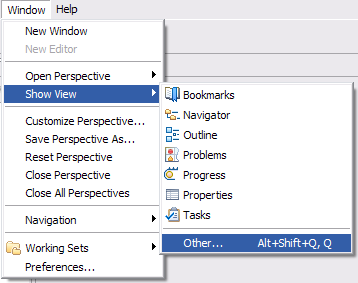
Within the show view dialog, locate AIML console, click it to highlight and then press
OK.

Now you should see something similar to this somewhere in Eclipse. This will be where we
will chat with our bot once we have loaded some AIML files into Eclipse
and have begun editing them.
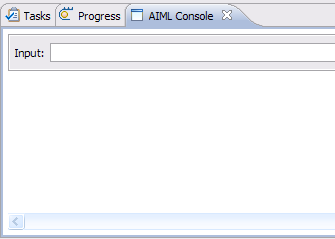
Let's create a new AIML project and then import some AIML files. To create a AIML project
click File->New->Project...

Now find and highlight RebeccaAIML Project and click next
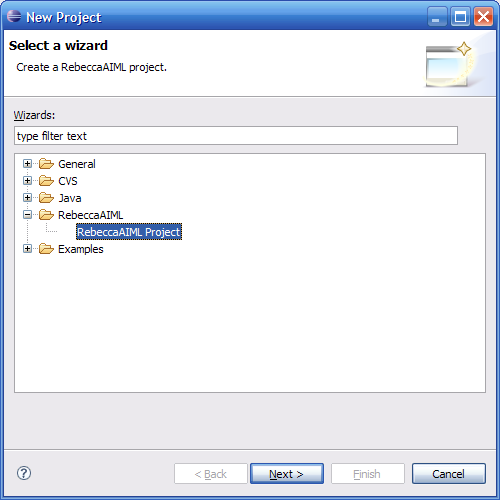
Give your project any name you want and click finish
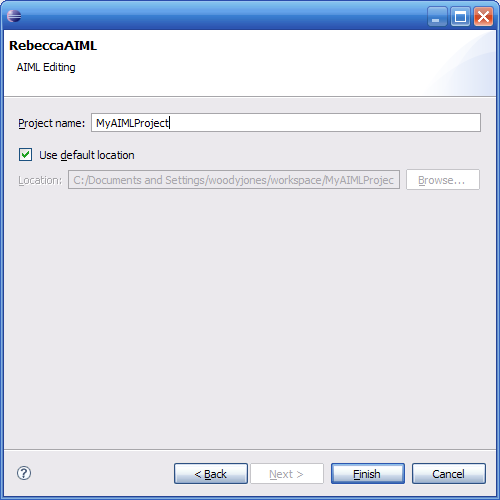
Now let us import some AIML files. We'll use the annotated
alice AIML set from RebeccaAIML's installation. Click
File->import
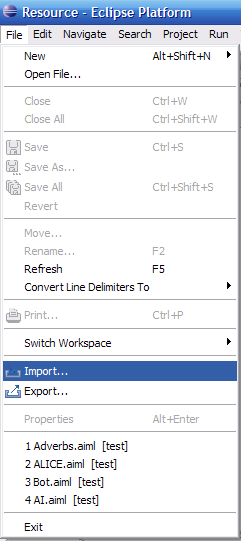
Highlight FileSystem and click next
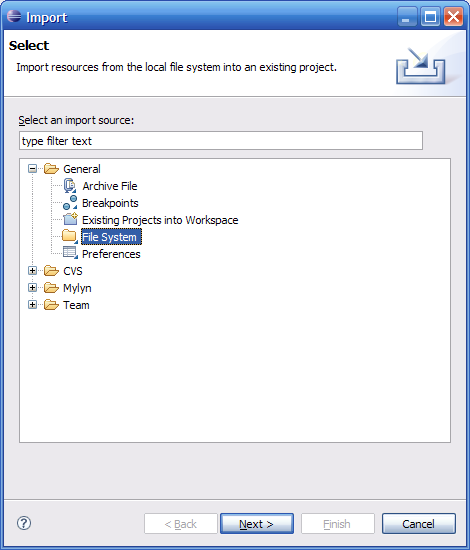
Browse to your RebeccaAIML installation and click the
annotated_alice folder. Put your base project name for the
folder you want to import into. Click finish
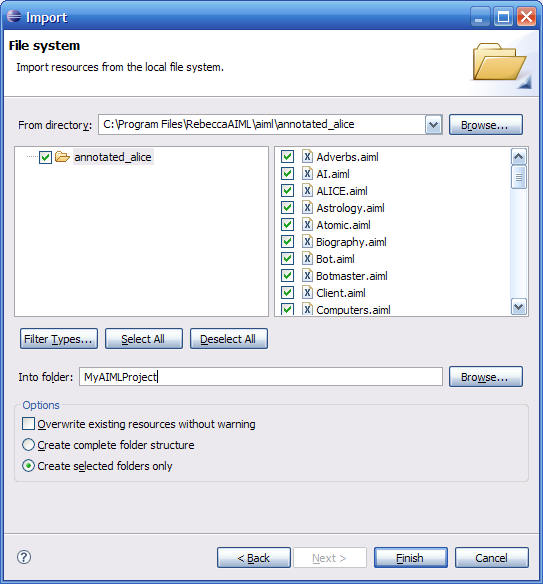
Once your files are moved over by Eclipse you should see the
workspace rebuilding its self in the lower right
hand of eclipse. This might take a while for the first time.

Now if you want you can chat using the AIML console
and it should chat back. The files imported into your
workspace are now added to the bot brain. Notice below that
the bot doesn't know your name or any information. You can
always use the rs-admin command line tool
to add predicates and tweek the bot if you want. Just don't
use rs-admin to add or remove AIML files. Eclipse will handle
that from here on out. The user id, bot id, and end user id
in which Eclipse uses is "eclipse" for all three in the embedded
database.
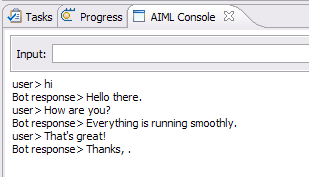
Let's click one of the AIML files on the left hand side of
the project Explorer. Choose Politics.aiml
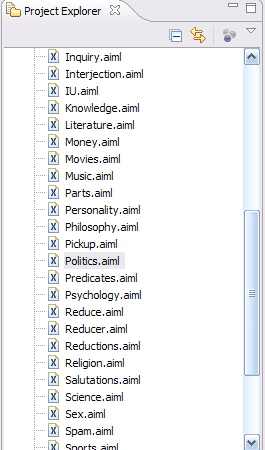
Type into your eclipse text editor
<category>
<pattern>DO YOU LIKE FIREARMS</pattern>
<template>Not all all!</template>
</category>
If you press cntrl-space you should see auto complete come up with suggetions.

After you finish your line of AIML, click save or press cntrl-s
to save your document. You should briefly see the message
"building workspace" in the lower right hand corner of Eclipse.
Every time you save an AIML document the brain is reloaded with the
changed document. In the AIML console type "do you like firearms"
and press enter. You should see the new response.
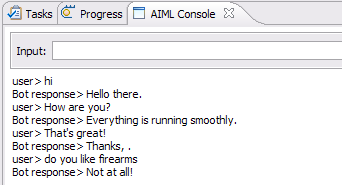
Eclipse offers such a rich built in XML editing enviornment
that I've only scratched the surface here. Explor on your own
and learn all the great things it offers such as spelling and
XML templates and anything else you could ever want. If you
haven't noticed by now, you should have seen several spelling
mistakes highlighted in yellow like so below. Feel free to
correct them if you want. You might not want to, if you want an
extra human element of Annotated Alice being a so-so speller
like myself.



































